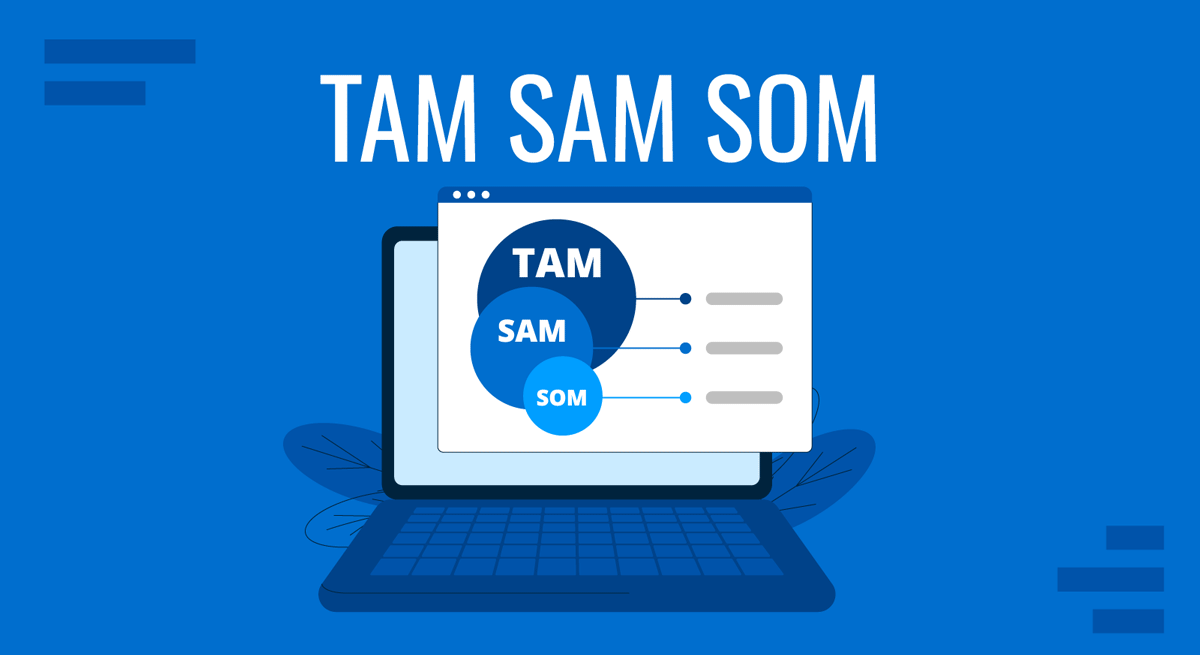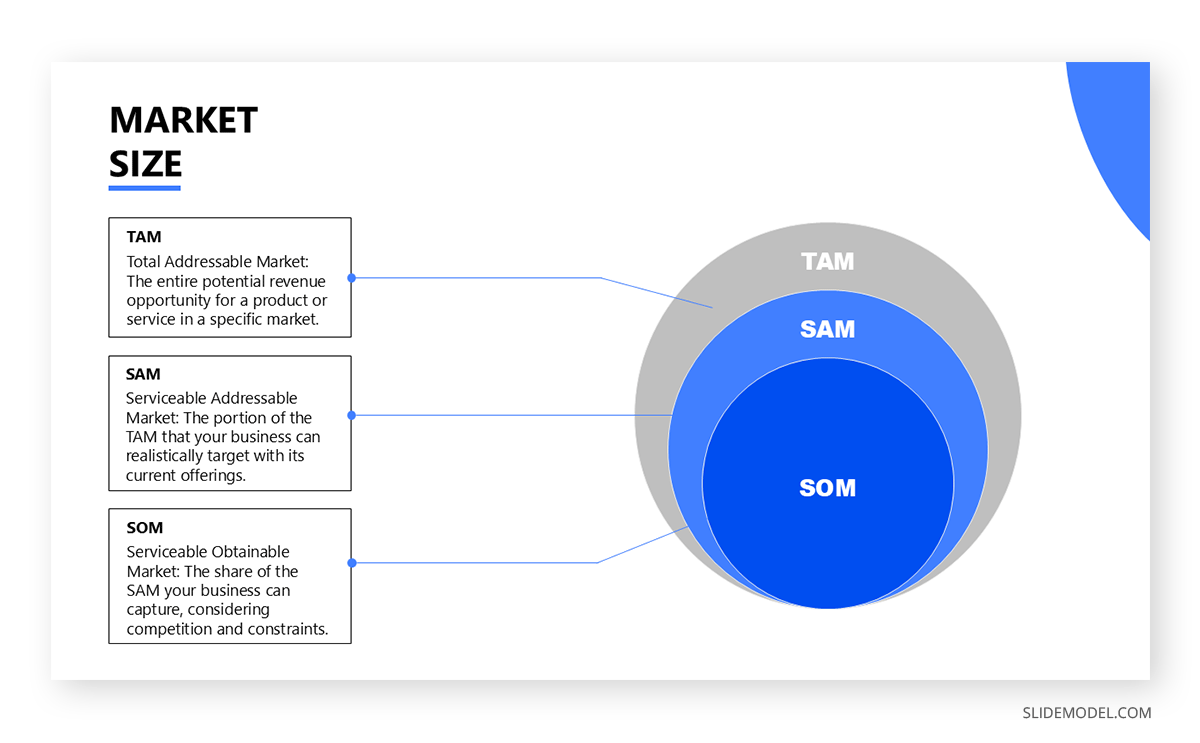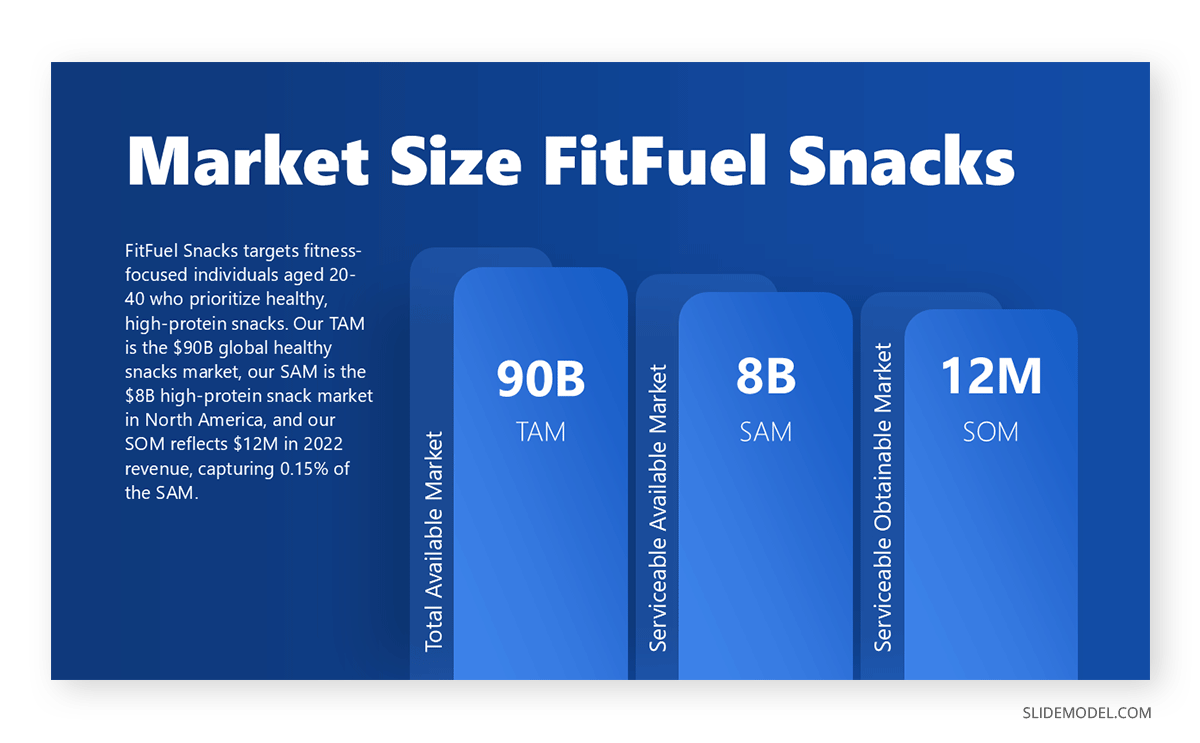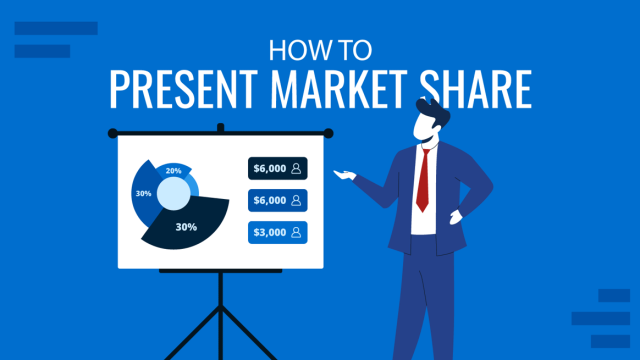
Few frameworks are as significant in business strategy and investor communication as TAM, SAM, and SOM. These acronyms, Total Addressable Market, Serviceable Addressable Market, and Serviceable Obtainable Market, form a triad of concepts that distill the vastness of market potential into actionable insights. When presented effectively, mainly through sophisticated graphical elements, TAM, SAM, and SOM transcend abstract metrics and become compelling narratives that resonate with stakeholders.
This article unpacks these concepts by providing a clear TAM SAM SOM definition, exploring their synergy with the marketing funnel (TOFU, MOFU, BOFU), and providing guidance on designing visually impactful presentations that elevate their strategic weight.
Table of Contents
- What is TAM, SAM, and SOM?
- What is PAM?
- How to calculate TAM SAM SOM?
- What is the link between TAM, SAM, and SOM and TOFU, MOFU, and BOFU?
- What kind of diagrams can I use to present TAM SAM SOM?
- Examples of how to Use TAM, SAM, and SOM
- FAQs
- Conclusion
What is TAM, SAM, and SOM?
At its core, the TAM, SAM, SOM framework is a hierarchical structure that narrows the lens of market opportunity from the broadest possible scope to the most immediate, actionable segment. The Total Addressable Market (TAM) represents the entire demand for a product or service across all conceivable customers, geographies, and use cases, assuming no competition or operational capacity constraints. The grand vision is the theoretical revenue ceiling if every potential customer were captured. For instance, a company developing a cloud-based project management tool might define its TAM as the global expenditure on project management software, encompassing every industry, organization size, and region where such tools could theoretically be adopted.
Narrowing this expansive view, the Serviceable Addressable Market (SAM) introduces realism by filtering the TAM through the lens of what the company can practically target given its current offerings, business model, and market access. This focus ties into broader market segmentation strategies for targeting viable customer groups. It is not about what could be sold in an ideal world, but what aligns with the company’s strategic capabilities. Continuing the example, the SAM for the project management tool might exclude industries with highly specialized needs (e.g., aerospace engineering) or regions where the company lacks distribution channels, focusing instead on mid-sized tech firms in North America and Europe where its features resonate most.
Finally, the Serviceable Obtainable Market (SOM) sharpens the focus further, representing the portion of the SAM the company can realistically capture in the short to medium term. This figure accounts for competition, market penetration rates, pricing strategies, and operational constraints like production capacity or sales bandwidth. For the cloud tool provider, the SOM might reflect a conservative estimate of market share among mid-sized tech firms in its primary regions, factoring in established competitors like Asana or Monday.com and the company’s current marketing budget.
Together, these three layers provide a structured narrative: TAM paints the big picture to inspire ambition, SAM grounds that ambition in strategic feasibility, and SOM delivers a pragmatic roadmap for execution. For a knowledgeable audience, be it investors, executives, or analysts, this framework is less about basic education and more about demonstrating rigorous market analysis and a clear path to value creation. This rigor underscores the importance of market research in defining TAM, SAM, and SOM.

What is PAM?
The Potential Addressable Market (PAM) is a market-sizing metric representing the total global demand for a product or service, even broader than the Total Addressable Market (TAM). While TAM captures the entire revenue opportunity for a specific product or service within a defined market, PAM includes all possible customers and use cases, regardless of current market constraints, geography, or product fit. It’s the most optimistic and expansive view of market potential, often encompassing future or hypothetical demand that could emerge with changes in technology, behavior, or market conditions.
For example, consider a company selling electric toothbrushes:
- TAM: The global market for electric toothbrushes is, say, $5 billion, assuming everyone who could buy one does.
- PAM: The global market for all oral hygiene products (including manual toothbrushes, floss, etc.), or even future innovations in oral care, is potentially worth $50 billion, including customers not currently in the electric toothbrush market but who could be in the future.
Key Characteristics of PAM
- Scope: Encompasses the entire theoretical market, including non-current users who could potentially adopt the product or service.
- Use Case: Often used to explore long-term growth opportunities, disruptive innovations, or markets that could be created or expanded.
- Calculation: Estimated using top-down approaches (e.g., global industry reports) or visionary assumptions about future market expansion. For instance, PAM = (Total potential customers, including future adopters) × (Average revenue per customer).
- Relation to TAM: PAM is always larger than or equal to TAM, as TAM is a subset of PAM constrained by current product or market realities.
How to calculate TAM SAM SOM?
With all concepts laid down, it’s time to address how can we calculate those metrics.
TAM (Total Addressable Market)
What it is: TAM is the total demand for your product or service across the entire market. It’s the biggest possible picture, like the whole pie of opportunity, if you could sell to everyone with no limits.
- Example: If you sell coffee, TAM is the total money spent on coffee worldwide.
- How to Calculate: Research the overall market size using industry reports, market research, or government data. For coffee, let’s say the global market is worth $100 billion.
- Key Point: This is the broadest view, assuming no competition or barriers.
SAM (Serviceable Addressable Market)
What it is: SAM is the portion of TAM you can actually target based on your business focus, like location or customer type. It’s a smaller, more realistic slice of the pie.
- Example: If your coffee shop is in New York, SAM is the coffee market in New York, not the world.
- How to Calculate: Narrow down TAM to your specific segment. Research shows New York’s coffee market is worth $1 billion.
- Key Point: This reflects who you can reach with your product or service.
SOM (Serviceable Obtainable Market)
What it is: SOM is the part of SAM you can realistically capture, considering competition and your capacity. It’s your achievable piece of the pie.
- Example: You aim to capture 5% of New York’s coffee market.
- How to Calculate: Estimate your market share. If SAM is $1 billion, 5% of that is $50 million.
- Key Point: This is your practical goal based on real-world factors.
What is the link between TAM, SAM, and SOM and TOFU, MOFU, and BOFU?
While TAM, SAM, and SOM are rooted in market sizing, their utility extends beyond static figures into the dynamic flow of customer acquisition and retention. This is where the marketing funnel, Top of the Funnel (TOFU), Middle of the Funnel (MOFU), and Bottom of the Funnel (BOFU) intersect with the framework, creating a powerful synergy for both planning and presentation. This linkage is not a rudimentary mapping for an advanced audience but a sophisticated integration that reveals how market potential translates into operational outcomes.
Recommended lecture: TOFU-MOFU-BOFU
At the TOFU stage, the focus is on awareness and reach, aligning closely with the TAM. This is the broadest layer of the funnel, where the goal is to cast a wide net and engage the full spectrum of potential customers identified in the Total Addressable Market. For the project management tool, TOFU activities might include thought leadership campaigns targeting all industries that could benefit from better collaboration, think global webinars, whitepapers on productivity trends, or broad-reach digital ads. The TAM informs the scope of these efforts, providing a benchmark for how expansive the audience could be if every barrier were removed.

As the funnel narrows to MOFU, the emphasis shifts to consideration and qualification, mirroring the SAM. Here, the company hones its efforts on the serviceable portion of the market—those prospects whose needs align with its offerings and who are accessible through existing channels. MOFU strategies might involve targeted case studies for tech firms, personalized demos showcasing integrations with tools like Slack, or content marketing that addresses specific pain points of mid-sized businesses. The SAM acts as a filter, ensuring resources are allocated to segments where the company has a realistic shot at conversion, rather than diluting efforts across the unattainable breadth of the TAM.
Finally, the BOFU stage parallels the SOM, where conversion and closure occur. This is the actionable core of the funnel, where leads become customers, and the company realizes its obtainable market share. For the tool provider, BOFU tactics could include competitive pricing offers, free trials with hands-on support, or customer testimonials from similar firms to seal the deal. The SOM provides the guardrails, ensuring that sales targets and forecasts reflect what’s achievable given current capabilities and market dynamics, rather than overpromising based on the broader SAM or TAM.

This alignment is not just conceptual; it’s a practical bridge between market analysis and execution. For a sophisticated audience, presenting TAM, SAM, and SOM alongside TOFU, MOFU, and BOFU demonstrates a holistic grasp of how market potential flows into customer acquisition, reinforcing credibility and strategic coherence.
What kind of diagrams can I use to present TAM SAM SOM?
For an audience knowledgeable in business strategy, the power of a TAM, SAM, SOM presentation lies not just in the numbers but in how those numbers are visualized. Graphical elements are the core of effective visual communication, transforming abstract data into intuitive, memorable insights. The challenge is to design visuals that are both analytically rigorous and aesthetically compelling, avoiding clichés like generic pie charts. Below, we explore advanced graphical strategies and enhancements to maximize impact.
Venn Diagrams
The most basic form of a TAM SAM SOM representation is an overly simplistic Venn diagram. TAM is the biggest element as it’s the total addressable market for your niche, then SAM and SOM, respectively, are nested inside TAM (and SAM for SOM). Visually, this speaks of the link between the market segments and intrinsic dependencies, which also simplifies explanations as there’s no SOM without SAM and TAM.

Using 3D PPT Templates
The most intuitive starting point is a concentric diagram. TAM, SAM, and SOM are depicted as nested shapes, typically circles or rings, radiating inward from the broadest (TAM) to the most focused (SOM). However, for a knowledgeable audience, this basic approach requires refinement.
Instead of flat, uniform circles, consider a three-dimensional conical projection, where the TAM forms a wide, translucent base that tapers through the SAM into a sharply defined SOM apex. This design conveys depth and hierarchy, suggesting that the SOM is not just a subset but the distilled outcome of strategic filtering.

Stacked-Chart Method
Another approach is a stacked area chart, particularly when presenting TAM, SAM, and SOM over time. This format excels at showing how these metrics evolve as the company scales or market conditions shift. Picture a multi-layered graph where the TAM forms a broad, stable foundation, the SAM fluctuates as the company refines its target segments, and the SOM grows incrementally as market share is captured.
Use distinct, harmonious colors, like deep teal, muted gold, and bold crimson, to differentiate each layer. Incorporate a subtle texture (e.g., a faint grid or wave pattern) to add visual sophistication. Annotate key inflection points, such as a product launch or market entry, with sleek, arrowed markers to tie the visual to the narrative, clarifying how strategy drives the numbers.
Integrating TAM SAM SOM with TOFU MOFU BOFU
A hybrid funnel-matrix design can be transformative for integrating the TOFU, MOFU, and BOFU linkage. Imagine a vertical funnel divided into three horizontal bands, each corresponding to a funnel stage: TOFU at the top, MOFU in the middle, and BOFU at the base. Overlay this with a semi-transparent TAM-SAM-SOM concentric overlay, where the TAM spans the entire funnel, the SAM narrows to MOFU and BOFU, and the SOM concentrates at BOFU.
This fusion visually ties market sizing to customer journey, with the funnel’s tapering shape reinforcing the progressive refinement from TAM to SOM. If the presentation is digital, enhance this with interactive elements, such as hover effects that highlight each segment’s data or clickable layers that drill into supporting metrics like conversion rates or acquisition costs. For static formats, use subtle shadows or glows to give the impression of depth, ensuring the graphic feels dynamic rather than flat.
Using Animations and Sliders
Finally, consider a temporal slider or animation for TAM SAM SOM for presentations. Rather than a static snapshot, let the audience see the TAM, SAM, and SOM evolve across a timeline, say, from Year 1 to Year 5, mirroring the company’s strategic roadmap. This dynamic element ties the market sizing to actionable milestones, reinforcing the link between vision and execution. For static formats, achieve a similar effect with a multi-panel sequence, each panel subtly advancing the story with updated data and refined visuals.
Examples of how to Use TAM, SAM, and SOM
The TAM, SAM, and SOM frameworks are powerful for communicating market potential. Below are TAM SAM SOM examples tailored to specific markets that illustrate how to apply and visualize these concepts in presentations.
Example 1: Pure Bliss Candles
Pure Bliss Candles is a brand dedicated to crafting natural, artisanal candles that transform any space into a cozy sanctuary. With a focus on sustainability and non-toxic ingredients, they cater to discerning consumers who seek a touch of luxury and wellness in their homes. Their candles are hand-poured with eco-friendly materials, appealing to women who value both ambiance and environmental responsibility.
Target Persona Characteristics:
- Women aged 25-50
- Enjoys creating a cozy home environment
- Values natural, non-toxic products
- Willing to pay a premium for artisanal and sustainable goods
Market Sizes:
- TAM (Total Addressable Market): The global candle market is valued at $13 billion USD.
- SAM (Serviceable Addressable Market): The natural and artisanal candle market in the United States is valued at $1.5 billion USD.
- SOM (Serviceable Obtainable Market): Pure Bliss Candles generated $3 million USD in revenue in 2022, capturing 0.2% of the SAM.
Example 2: FitFuel Snacks
FitFuel Snacks is on a mission to fuel active lifestyles with convenient, high-protein snacks. Their innovative products are designed for fitness-focused individuals who demand both taste and nutrition in their on-the-go snacks. By blending health-conscious ingredients with bold flavors, FitFuel Snacks has carved out a niche among social media-savvy consumers who prioritize wellness without compromising on convenience.
Target Persona Characteristics:
- Men and women aged 20-40
- Fitness-focused individuals who prioritize healthy eating
- Seeks convenient, high-protein snack options
- Active on social media and follows fitness influencers
Market Sizes:
- TAM (Total Addressable Market): The global healthy snacks market is valued at $90 billion USD.
- SAM (Serviceable Addressable Market): The high-protein snack market in North America is valued at $8 billion USD.
- SOM (Serviceable Obtainable Market): FitFuel Snacks earned $12 million USD in revenue in 2022, capturing 0.15% of the SAM.

Example 3: ZenFlow Yoga Mats
ZenFlow Yoga Mats combines eco-conscious materials with sleek design to create yoga mats that are as beautiful as they are functional. Their products resonate with yogis and mindfulness practitioners who value sustainability, durability, and aesthetics in their fitness gear. By offering mats that enhance both the practice and the planet, ZenFlow has become a go-to brand for those seeking harmony in their wellness routines.
Target Persona Characteristics:
- Men and women aged 18-45
- Practices yoga or mindfulness regularly
- Prefers eco-friendly and durable fitness gear
- Values aesthetics and functionality in products
Market Sizes:
- TAM (Total Addressable Market): The global yoga equipment market is valued at $16 billion USD.
- SAM (Serviceable Addressable Market): The eco-friendly yoga mat market in Europe is valued at $2 billion USD.
- SOM (Serviceable Obtainable Market): ZenFlow Yoga Mats achieved $4 million USD in revenue in 2022, capturing 0.2% of the SAM.
Using vector image slide decks can save us countless hours, as we can pair the TAM SAM SOM diagrams with professionally designed graphics to connect with our presentation topic.
FAQs
Why is TAM SAM SOM important?
TAM, SAM, and SOM are essential for clearly defining the market opportunity and setting realistic business goals. They help prioritize resources, shape go-to-market strategies, attract investor confidence, and guide internal decision-making. By quantifying potential and attainable market shares, businesses can avoid overestimating opportunities and make informed, data-driven choices about where to compete and grow.
How can I visually present TAM, SAM, and SOM in a business presentation to maximize audience engagement?
Use clear, layered visuals such as concentric circles or segmented funnel diagrams. Start with TAM (Total Available Market) as the broadest layer, then SAM (Serviceable Available Market), and finally SOM (Serviceable Obtainable Market) as the narrowest. Keep text minimal, use contrasting colors, and guide the audience through the diagram verbally to reinforce understanding without overwhelming the slide.
What are the most common mistakes when explaining TAM, SAM, and SOM to non-technical or executive audiences?
Common mistakes include using too much technical jargon, presenting overly detailed data without summarizing key insights, and assuming the audience understands market sizing frameworks. For non-technical or executive audiences, simplify language, focus on the strategic relevance (why the numbers matter), and avoid overwhelming charts. Prioritize storytelling over raw data delivery.
What role does pricing strategy play in defining SOM?
Pricing directly influences SOM by determining affordability and competitive positioning within the SAM. A premium pricing model might shrink the SOM by excluding price-sensitive customers, while a penetration strategy could expand it by capturing a larger share of cost-conscious segments. Model SOM under different pricing scenarios to reflect elasticity and market response.
How detailed should a TAM, SAM, SOM slide be during an investor pitch or business proposal presentation?
The slide should be high-level and easy to grasp in under 30 seconds. Use one or two key numbers per layer, mention your main sources briefly, and highlight the SOM clearly, since it reflects the realistic opportunity for your business. Investors and decision-makers typically look for credibility and realism, not exhaustive market reports within the pitch deck itself.
How can TAM, SAM, and SOM be adjusted for disruptive technologies?
Disruptive technologies expand TAM by creating new demand (e.g., smartphones birthing app ecosystems) while reshaping SAM and SOM based on adoption curves. Use scenario analysis to project TAM growth from emerging use cases, refine SAM by early adopter segments, and constrain SOM by initial penetration barriers like infrastructure or awareness.
Regulations can cap TAM by restricting market entry (e.g., data privacy laws limiting SaaS expansion), narrow SAM by excluding non-compliant segments, and shrink SOM through compliance costs or delays. Quantify these effects with legal analysis or precedent-based estimates, adjusting projections accordingly.
Should I include TAM, SAM, and SOM in every business presentation?
Only include TAM, SAM, and SOM when discussing market opportunities, strategic planning, product launches, or funding proposals. If the presentation focuses on operational matters or internal processes, it might not be relevant.
How do you account for seasonality in TAM, SAM, and SOM?
Seasonality affects demand cycles, particularly in industries like retail or agriculture. Adjust TAM to reflect peak annual potential, SAM to prioritize segments with consistent year-round needs, and SOM to align with operational capacity during high-demand periods. Present averages alongside seasonal peaks for clarity.
How do I adapt my TAM, SAM, SOM messaging depending on audience size?
For larger audiences (keynotes), focus on broader trends and simplified visuals to maintain attention. For smaller, focused audiences (like a boardroom), you can dive deeper into assumptions, sources, and methodology behind your figures. Adapt your tone too: use storytelling and big-picture impacts for keynotes, and use evidence-based reasoning for smaller, decision-making groups.
Can TAM, SAM, and SOM be applied to non-profit organizations?
Yes, but the focus shifts from revenue to impact metrics like beneficiaries served or donations raised. TAM becomes the total population or funding pool addressable, SAM narrows to reachable constituencies given the mission scope, and SOM reflects achievable outcomes based on resources and partnerships.
What’s the best way to present TAM, SAM, and SOM for a subscription-based business?
Emphasize recurring revenue potential by framing TAM as total lifetime value across all possible subscribers, SAM as addressable subscribers given churn rates, and SOM as achievable subscribers based on acquisition and retention metrics. Use cohort analysis visuals to show subscription growth trends.
Is it better to show TAM, SAM, and SOM separately or on a single slide?
A single slide with a layered visual works best for short presentations or pitches. You can introduce each metric separately in longer presentations and build up to a final, summarized graphic for better audience understanding.
How do I update TAM, SAM, SOM figures over time?
Review and update market sizing regularly as your business grows, competitors emerge, or new data becomes available. Market conditions change, and updated figures show agility and awareness in business planning.
What’s the role of customer lifetime value (CLV) in refining SOM?
CLV refines SOM by tying obtainable market share to long-term profitability per customer, rather than just initial sales. Multiply CLV by estimated customer acquisition numbers within the SAM to derive a more precise SOM, adjusting for retention rates and upsell potential.
What is the difference between top-down and bottom-up approaches for TAM, SAM, SOM?
Top-down uses overall industry data and narrows down to your specific market. Bottom-up builds estimates based on real-world data, like customer acquisition cost, number of potential clients, or geographic reach. Combining both improves accuracy and credibility.
Conclusion
TAM, SAM, and SOM are more than metrics—they are a language for translating market potential into strategic intent. For a knowledgeable audience, the challenge is to present these concepts with the depth and sophistication they deserve, weaving them into the marketing funnel and amplifying their impact through graphical excellence.
By moving beyond basic charts to layered, data-rich visuals—conical projections, stacked evolutions, funnel-matrix hybrids, and competitive overlays—the presenter can transform numbers into a compelling story of ambition, focus, and achievement. Add risk adjustments, temporal dynamics, and contextual enhancements, and the result is a presentation that informs and inspires, leaving stakeholders with a clear, memorable vision of the company’s place in the market.


